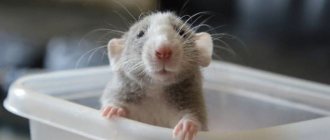Reasons for circling in hamsters
Circling in hamsters occurs when the hamster tilts its head. A drooping head is usually the result of an inner ear infection caused by bacteria, but there are other causes.
An inner ear infection causes bacteria from a dirty environment or respiratory infection to enter the ear canal. The pressure that an infection causes inside the ear canal can cause your hamster to lose balance and feel pain. This causes the hamster to spin around when walking, and some hamsters may even fall.
Neurological problems due to injury or brain disease such as epilepsy can also cause circling in hamsters. These problems are not as common as a bacterial ear infection, but are still possible causes of this behavior.
Why is the hamster shaking, breathing rapidly and becoming lethargic?
In addition to the reasons listed, trembling, rapid breathing and lethargy in a hamster can occur in the following cases:
- Shortness of breath, rapid heartbeat, or trembling may be a sign of anxiety.
- Problems with the nervous system and mild excitability can cause trembling when you sharply touch or pick up an animal. Overstimulation of the system causes unusual muscle movements and thus tremors in the body. Try to handle a nervous pet delicately so as not to scare it. Hamsters are usually afraid of sudden noise, changes in their usual environment, sudden movements, and other animals near their home. But in such cases, the trembling is not continuous and stops after some time.
- Medical conditions such as diabetes, stroke, heart failure, skin parasites, heat stroke, and poisoning can cause trembling, lethargy, and shortness of breath. Shaking is a common sign of a health problem in hamsters.
- If your hamster has a stroke, he will appear dizzy, oscillate back and forth even while sitting, and shake. A stroke can have mild or severe course and consequences, but they can go away over time.
- Age-related changes in an animal can also cause trembling and lethargy. Older hamsters (over 1.5 years old) are more likely to have strokes.
Diagnosis of the cause of the cycle in hamsters
Although hamsters circling may be an obvious behavior to observe, it may be necessary to perform some tests in order to know exactly what is causing it.
Since the most likely cause of circling is an ear infection, debris from your hamster's ear can be examined under a microscope. This will check whether bacteria caused by the infection is present and, if so, an ear infection will be diagnosed.
Neurological problems are more difficult to diagnose. If your hamster has recently been injured before circling, it may mean he has suffered a head injury. Falling, being grabbed by a dog, or colliding with a door or piece of furniture are all types of injuries that can cause a head injury.
Seizures are a symptom that overlaps with epilepsy, another neurological problem. There is no test for epilepsy. In these cases, constant close monitoring may be required and the veterinarian will be able to video record any unusual behavior.
Video "Falling Hamster"
In this video, a rodent comically climbs and falls on its back.
Was this article helpful?
Thank you for your opinion!
The article was useful. Please share the information with your friends.
Yes (28.57%)
No (71.43%)
X
Please write what is wrong and leave recommendations on the article
Cancel reply
Rate the benefit of the article: Rate the author ( 9 votes, average: 4.44 out of 5)
Discuss the article:
Treatment of circling in hamsters
Constant or severe circling in hamsters always merits a visit to the veterinarian.
If the behavior is caused by an ear infection, hamster-safe antibiotics will need to be prescribed as treatment. Without them, your hamster's ear may be permanently damaged and the circling may never stop. Infections can also lead to more serious complications, which in extreme cases can be life-threatening. Treatment of the infection may require oral antibiotics and sometimes pain medications. If debris is visible from the ears, gentle cleaning may also be helpful.
If the circling is not due to an ear infection, it may be more difficult to treat. Brain damage from seizures or head trauma may be permanent. Some circling will resolve on its own over time, but in some hamsters the circling may be permanent. If the circling is so bad that it is affecting your hamster's quality of life and he is unable to eat, then euthanasia can be discussed.
Temperature-related disorders
If a previously healthy animal suddenly falls into a coma, it is possible that it is hibernating. Breathing will be very rare, and the pet will be cold to the touch. In nature, dwarfs hibernate in winter, waiting out cold, hunger and short daylight hours.
Low room temperature
If the heating was turned off in the apartment, or you did not feed the hamster for several days while going on vacation, this could provoke torpor. The body will be cold, the heartbeat will be extremely rare (1 beat every 15 seconds). A sleeping hamster can barely breathe; due to its small size, it is difficult to understand whether there is breathing at all. But if the body remains soft, the rodent has not died. To awaken the animal, the cage is placed in a warm room (more than 20 C), the feeder and drinking bowl are filled. The hamster should wake up in 2-3 days.
Heat
The Djungarian hamster lives in the steppes, and the Syrian even in semi-deserts, but both species are extremely sensitive to high temperatures and direct sunlight. Tiny nocturnal rodents with dense fur have no protection from overheating - they do not sweat or breathe through their mouths like dogs. Heat stroke is deadly for them.
Signs of hyperthermia:
- the hamster does not move and is breathing heavily;
- weakness;
- convulsions;
- impaired coordination of movements.
In case of acute overheating, heart failure leads to the death of the pet. Death may not occur immediately, but within a couple of days due to the failure of all organs, if the temperature has risen so much that proteins have coagulated in the blood and organs (at 44 C).
Situations in which there is a risk of heat stroke:
- transportation in a car;
- a cage on a windowsill or balcony, outside (sun);
- near heating devices;
- in a stuffy room with high humidity.
It can be difficult to understand why a hamster is lying on its side and breathing heavily if by the time the owner returns the sun has already gone and does not illuminate the cage.
Treatment for heat or sunstroke
Transporting a pet to a clinic in case of heat or sunstroke is not the best solution; time for first aid will be missed. What can you do without the help of a veterinarian to help your pet:
Reduce temperature
First aid is to cool the body, but not too sharply: applying ice or immersing the hamster in water is prohibited! The animal is placed on a tile or ceramic dish, or on a damp towel. Gently wet ears and paws with cool water.
Fighting dehydration
Heat stroke very often occurs when there is no access to fresh drinking water. When the animal is unconscious, it can no longer use the drinking bowl. However, it is also dangerous to drink a hamster from a syringe: it will not swallow, and the liquid will enter the lungs, making breathing difficult and causing pneumonia.
The liquid (sterile Ringer's solution or sodium chloride) is injected subcutaneously into 4-8 ml of Syrian and 2 ml of Djungarian hamsters.
Antishock therapy
Although all potent medications are best used as prescribed by a doctor, in a situation with acute overheating, the hamster may not survive to take the ratologist. If you feel like you have nothing to lose, you should inject prednisolone 30 mg/ml intramuscularly (in the hind leg) with an insulin syringe. The dose for a Dzhungarik is 0.05 ml, for a Syrian - 0.1 ml.
The prognosis is unfavorable: the pet may die
Whether your pet survives may depend on how long it was exposed to the high temperature. If the hamster does not die immediately, on the first day after overheating the owner often notices that the hamster falls over on its side and can barely walk. Neurological disorders are associated with swelling of the brain, and if the pet survives, coordination of movements will gradually be restored.
How to prevent hamsters from circling
Hamsters are small pets that love to hide. It can be difficult to notice when they are acting a little strange in their cages, but regularly observing your hamster's normal activities can help spot the beginning of a problem. This, along with regular cage cleaning and washing cage supplies, can help prevent ear infections that cause circling.
To avoid head injuries that could lead to dizziness, only allow children to handle the hamster when they are sitting on the ground. This will reduce the chance of your hamster falling and getting injured. When your child is finished holding the hamster, either place the cage on the floor to put them back in, or carefully take the hamster from your child so you can carefully place it back in the cage yourself.
Keep your hamster safe if you have dogs or cats in the house when they are out of their cage, and make sure their cage is secure and locked at all times.
Accidents can happen, but they are much less likely if you pay close attention and take extra precautions.
Other diseases
Pets do not get sick very often if they are properly cared for in a timely manner and fed a balanced diet, with the exception of congenital pathologies. In addition to a specific disease characteristic of animals - inflammation of the cheek pouch, they are also affected by viruses, bacteria, and parasites. As a result, the animal becomes inactive and refuses food and drink. If you do not pay attention to the unnatural behavior of your ward and do not provide timely medical assistance, the pet may die.
Did you know? Golden Syrian hamsters have four toes on their front feet and five
-
on the rear.
For example, as a result of a blow or a fall from a height, difficulty breathing, twisting of the head and refusal to eat may occur. In this case, it is advisable to contact a ratologist. If the hamster is already at an “advanced age,” then it can become severely paralyzed. On average, the lifespan of these rodents is 1.5–2 years. Some live up to three years.
Pneumonia
The development of the disease is possible when the animal’s immune defense is weakened due to a deficiency of vitamins, minerals, and amino acids in the feed.
The causes of such a serious disease may be:
- prolonged hypothermia as a result of a draft or low temperature combined with high humidity in the room where the animal lives;
- virus;
- chronic otitis, in which the animal shakes its head, and wax accumulates in the auricle, a crust forms and an unpleasant odor emanates;
- hypo-or vitamin deficiency as a result of an unbalanced diet;
- ophthalmological diseases.
Did you know? Fluffy pets cannot boast of good eyesight - they are nearsighted and trust their sense of smell more; moreover, they do not distinguish colors, that is, they are color blind.
Symptoms indicating the development of pneumonia include:
- rapid breathing, accompanied by sniffling, wheezing, gurgling in the lungs;
- profuse mucopurulent discharge from the nose and eyes;
- lethargic state;
- coughing attacks, shortness of breath;
- pallor of the mucous membranes;
- the animal stops eating;
- the animal freezes in one place, without moving, because he is choking.
Pneumonia is treated with antibiotics. The drug Baytril, 2.5%, is suitable for small rodents. A dose of 0.4 ml is calculated for an animal weighing 1 kg. The average weight of a Djungarian hamster is 50 g. Therefore, a dose of 0.01 ml will be sufficient for him.
The injection is given under the skin daily for two weeks. Additionally, sulfonamide drugs are used, which have an antimicrobial effect. If treatment is carried out in a timely manner, the hamster will fully recover.
Poisoning
Symptoms of the pathological condition include:
- bowel dysfunction;
- rumbling in the stomach;
- loss of appetite;
- lethargy.
The best option would be to consult a specialist to find out the cause of the digestive process disorder, determine the correct diagnosis and prescribe appropriate treatment. These symptoms accompany not only poisoning, but also gastrointestinal diseases, food allergies, and enteritis.
Important! Dehydration, which is the result of severe diarrhea or elevated body temperature, can cause lethargy, weakness, exhaustion, slow breathing of the animal and very rapid death.
Factors that can provoke this condition in a patient include:
- violation of feeding regime;
- the use of a diet of poor quality or poor in nutrient ratios;
- the effect of various toxins on the rodent’s body.
If there is a suspicion that the baby has eaten low-quality food, it is advisable to give him half a tablet of activated carbon and fill the drinking bowl with fresh water. You can use Enterosgel - it helps remove toxic substances. To restore the acid-base balance, use "Regidron". After providing first aid, it is advisable to show the hamster to a veterinarian.
Diarrhea in a rodent can be triggered by a sudden change in diet or too large a dose of fresh vegetables, fruits and herbs. Very soft or runny stools will leave your pet's fur in the anus area wet or dirty. With severe diarrhea, there is a risk of dehydration, so it is advisable to force water on your pet.
Find out what diseases hamsters have.
Vegetables, fruits, and greens should be excluded from the diet and the pet should be switched to dry food. Feed your hamster raspberry leaves and rice water - these foods will help hold the stool together. If after 2 days the diarrhea has not stopped, take your ward to the veterinarian - perhaps the digestive upset was caused by other reasons. After bowel movements are restored, gradually introduce small doses of fresh fruits and vegetables into your diet.
Tumors, metastases
Animals are often diagnosed with pathological formations on the body, limbs, and ears. The reasons for their development are different. For example, a lump appears as a result of an injury, a severe bruise when falling from a height. Treatment begins with a diagnosis by a physician-ratologist.
If a benign or malignant tumor is detected, surgery is prescribed. If the tumor is located in a hard-to-reach place, for example, in the oral cavity, or metastases are found in other organs, veterinarians advise euthanasia, because Treatment methods do not give the desired results.
General symptoms of all hamster diseases
Symptoms of a hamster's disease will be noticeable to the owner during daily contact with the animal. But there are also subtle symptoms of a pet’s poor condition.
Symptoms of hamster disease:
- Refusal to eat.
- Lethargy, apathy.
- Lack of activity, movement, long periods of sleep.
- Aggression.
- One or both eyes are closed (hamster eye disease).
- Sudden weight gain or loss for no apparent reason.
- Dull, falling out hair, bald spots.
- Accumulating droppings on the fur near the genitals.
- Discharge of pus from the eyes, ears, mouth.
Knowing the general symptoms of hamster disease, you can easily determine whether your pet is healthy or not.
Diurnal or nocturnal animal
In the wild, representatives of the hamster family are nocturnal animals. During the day they sleep. These habits have also been preserved in domestic pets.
Is it possible to wake up a pet during the day?
Waking rodents during the day is prohibited. Attempts by the owners to change the animal’s regime will become a great stress for it, will lead to the development of pathologies, and will negatively affect life expectancy. It is better to let the hamster sleep. An awakened pet becomes aggressive and irritable. It can bite its owner if he reaches out his hand.
Why does a hamster sleep all the time?
The reason why a hamster constantly sleeps may be a change of residence or a move. During the first week, the animal hardly rests, as it actively explores the new territory and arranges its home. Then the adaptation is completed, the pet needs to relax. During this period, sleep can be up to 20 hours daily. The rodent leaves the house only for food or water. This behavior is normal and does not require intervention from the owners.
The hamster sleeps constantly due to a change of residence.
Inactivity is also possible due to illness. Take your pet to a veterinarian if the following symptoms are observed:
- sleep for 20 hours a day or more;
- lethargy, lack of interest in toys, communication with owners;
- loss of appetite to complete absence;
- aggressive behavior;
- weakness, difficulty moving around the cage;
- discharge from the nose or eyes;
- dull, matted fur;
- wet tail;
- wet fur on the chin, neck;
- lack of washing, licking;
- stool disorders, changes in the appearance or consistency of droppings.
Timely treatment will help save the animal.











